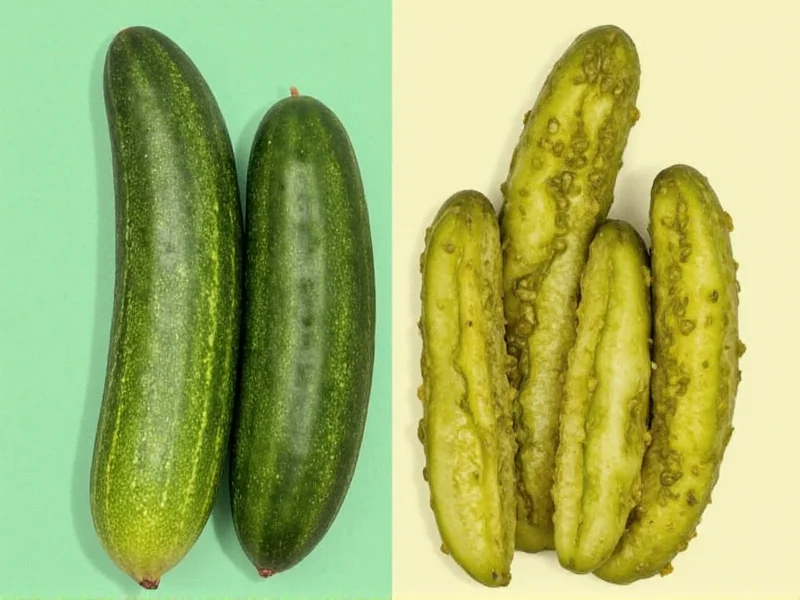Pickles are not a separate vegetable but rather cucumbers that have undergone a preservation process called pickling. The fundamental difference between cucumbers and pickles is that cucumbers are fresh vegetables harvested from the vine, while pickles are cucumbers that have been preserved in a solution of vinegar, salt, and spices, which transforms their flavor, texture, and nutritional profile.
Understanding the difference between cucumbers and pickles is essential for both culinary applications and nutritional awareness. Many people mistakenly believe pickles are a distinct vegetable variety rather than a preparation method for cucumbers. This confusion often stems from regional terminology differences and the dramatic transformation that occurs during the pickling process.
What Exactly Are Cucumbers?
Cucumbers (Cucumis sativus) are members of the Cucurbitaceae family, which includes melons and squash. These refreshing vegetables consist of approximately 95% water, making them exceptionally hydrating. They grow on creeping vines and come in various types:
- Slicing cucumbers - Longer varieties with dark green skin, typically eaten fresh
- Pickling cucumbers - Shorter, thicker-skinned varieties specifically bred for preservation
- English cucumbers - Often seedless with thinner skin, commonly found shrink-wrapped in grocery stores
The Pickling Transformation Process
Pickles are created when cucumbers undergo a preservation method that fundamentally alters their characteristics. This process involves several key steps:
- Selection of appropriate cucumber varieties (typically smaller, firmer pickling cucumbers)
- Submersion in a brine solution (usually containing vinegar, salt, and water)
- Addition of flavoring agents like dill, garlic, mustard seeds, and other spices
- Either fermentation (lacto-fermentation) or quick pickling using vinegar
- Storage in airtight containers for preservation
During this transformation, beneficial bacteria convert natural sugars into lactic acid in fermented pickles, creating that distinctive tangy flavor while preserving the vegetable. Vinegar-based pickles achieve their sour profile more quickly through acidification rather than fermentation.
Physical and Sensory Differences
The pickling process creates noticeable changes in several characteristics:
| Characteristic | Cucumber | Pickle |
|---|---|---|
| Texture | Crisp but relatively soft, high water content | Firmer, crunchier texture due to pectin breakdown and calcium addition |
| Flavor | Mild, slightly sweet, refreshing | Tangy, sour, with complex spice notes depending on preparation |
| Color | Bright green skin, pale green interior | Darker green (sometimes yellowish) due to brine interaction |
| Shelf Life | 1-2 weeks refrigerated | Several months to years when properly canned |
Nutritional Comparison: Cucumber vs Pickle
While both originate from the same vegetable, the pickling process significantly alters the nutritional profile:
- Calorie content remains relatively similar (both are low-calorie foods)
- Sodium levels increase dramatically in pickles due to the brine (a single dill pickle can contain 30% of daily recommended sodium)
- Vitamin content changes - some vitamins degrade while beneficial probiotics develop in fermented varieties
- Antioxidant levels may increase in certain pickling methods
- Probiotic content develops in naturally fermented pickles but not in vinegar-brined varieties
For those monitoring sodium intake, fresh cucumbers provide hydration and nutrients without the added salt. However, fermented pickles offer gut-health benefits from probiotics that fresh cucumbers lack.
Why Specific Cucumber Varieties Are Used for Pickling
Not all cucumbers make good pickles. Pickling cucumbers (often called Kirby cucumbers) have distinct characteristics that make them ideal for preservation:
- Thicker skin that withstands the pickling process without becoming mushy
- Fewer seeds and less water content than slicing varieties
- Smaller size and uniform shape for consistent processing
- Higher density that maintains crispness during preservation
Using standard slicing cucumbers for pickling often results in softer, less crisp pickles because their thinner skin and higher water content don't hold up as well to the brining process.
Common Misconceptions About Cucumbers and Pickles
Several misunderstandings persist about the relationship between these two food items:
- Misconception: Pickles are a different vegetable than cucumbers
Reality: All pickles start as cucumbers, but not all cucumbers become pickles - Misconception: The term "pickle" refers to the same thing worldwide
Reality: In the UK and some Commonwealth countries, "pickle" refers to a relish-like condiment made from various vegetables - Misconception: Pickling destroys all nutritional value
Reality: While some nutrients change, pickling preserves many vitamins and can enhance certain beneficial compounds
Culinary Applications: When to Use Each
Understanding the difference between cucumber and pickle helps determine appropriate culinary uses:
- Use fresh cucumbers when: You want maximum hydration, mild flavor, or crisp texture in salads, sandwiches, or as a fresh snack
- Use pickles when: You need tangy flavor, extended shelf life, or probiotic benefits (in fermented varieties)
- Substitution note: Fresh cucumbers cannot substitute for pickles in recipes requiring that distinctive sour flavor, and vice versa
Chefs often select specific pickle varieties based on the desired flavor profile - dill pickles for savory applications, sweet pickles for contrasting flavors, and bread-and-butter pickles for balanced sweet-sour notes.
The Science Behind the Transformation
The metamorphosis from cucumber to pickle involves fascinating biochemical processes. In fermented pickles, naturally occurring Lactobacillus bacteria convert cucumber sugars into lactic acid through anaerobic fermentation. This acidification:
- Lowers pH to preserve the vegetable
- Creates complex flavor compounds
- Develops beneficial probiotics
- Alters texture through controlled enzymatic activity
Vinegar-based pickling achieves similar preservation through direct acidification rather than bacterial fermentation, resulting in a different flavor profile and lacking probiotic benefits.











 浙公网安备
33010002000092号
浙公网安备
33010002000092号 浙B2-20120091-4
浙B2-20120091-4